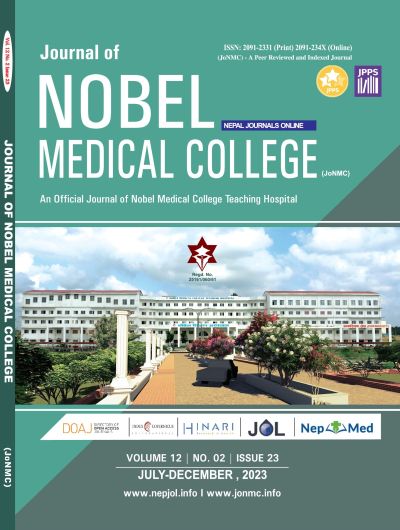Prevalence of Depression and Anxiety Symptoms among Patients with Hypothyroidism in a Tertiary Care Centre
DOI:
https://doi.org/10.3126/jonmc.v12i2.61110Keywords:
Depression and anxiety disorders, Hypothyroidism, Mental disordersAbstract
Background: The correlation between depression, anxiety and thyroid function is widely recognized. These conditions exhibit numerous similar symptoms, which complicates the process of diagnosing and treating them. The aim of this study is to determine the frequency of Anxiety Symptoms in Individuals with Hypothyroidism at a Specialized Medical Facility.
Materials and Methods: A comprehensive assessment was conducted on 100 individuals who had been diagnosed with hypothyroidism. The evaluation involved the utilization of the Hamilton Depression Rating Scale (HDRS) and the Hamilton Anxiety Scale (HAM-A). The study included participants of all genders, ranging in age from 18 to 45 years, who had confirmed diagnoses of hypothyroidism and provided their explicit written consent.
Results: Out of the participants, 73% were females and 27% were males. Among the total sample, 63% displayed different levels of depression based on the HDR Scale, while 65% exhibited varying degrees of anxiety according to the HAM-A scales. When considering males, the most prevalent symptoms in line with the HDR scales were feelings of depression (74.07%) and anxiety (85.18%). Conversely, among females, the most frequent symptoms were somatic symptoms related to the gastrointestinal system (69.86%). Analyzing the HAM-A scales, the primary symptom for males was depressed mood (92.59%), whereas for females, it was anxious mood (93.15%).
Conclusion: There is significant prevalence of depression and anxiety among the patients with hypothyroidism.
Downloads
Downloads
Published
How to Cite
Issue
Section
License
Copyright (c) 2023 Mukti Acharya, Deepak Karki, Surendra Prasad Shah

This work is licensed under a Creative Commons Attribution 4.0 International License.
JoNMC applies the Creative Commons Attribution (CC BY) license to works we publish. Under this license, authors retain ownership of the copyright for their content, but they allow anyone to download, reuse, reprint, modify, distribute and/or copy the content as long as the original authors and source are cited.




